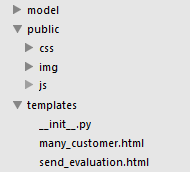最近在推进项目使用grunt。具体各步骤操作的原理网上很多详细的,但尝试的过程中还是遇到了不少坑。现在写一写自己的安装使用过程
安装
nodejs。sudo apt-get install nodejs安装命令行的
grunt(grunt-cli) sudo npm install -g grunt-cli(现在的nodejs版本已经自带npm了)建立一个
grunt文件夹(mkdir grunt),进入此文件夹,运行npm init,生成package.json文件,(注意:此时配置的name值不能和文件夹同名)加载插件
npm install grunt --save-dev,npm install grunt-contrib-concat grunt-contrib-clean grunt-contrib-copy grunt-contrib-cssmin grunt-contrib-imagemin grunt-contrib-uglify grunt-rev grunt-usemin --save-dev(分别对应:合并,清除文件,拷贝文件,css压缩,图片压缩,js压缩,修改文件名,修改html页面引用路径)新建
Gruntfile.js,写好配置js即可运行了。
下面,结合我自己的项目说说Gruntfile.js的写法。
我的项目结构:public 文件夹 + templates

首先,将public和templates复制到grunt的安装目录下
我的需求是:将公用的几个css合并成一个build.css,几个公用的js合并成一个build.js,然后对public下所有的文件压缩,然后修改文件md5名称,并在html页面及CSS和js里修改相对应的引用,最后在dist目录下生成执行完操作后的public和templates文件夹,这样,直接将服务器上的这两个文件夹直接替换掉就可以了,本地的开发环境下依然是开发的文件
Gruntfile.js:
module.exports = function(grunt) {
grunt.config.init({
// 清空"生产环境"文件夹的文件
clean: {
html: {
src: "dist/"
},
js: { // 清除复制过来js文件里已合并的js
src: [
'dist/public/js/zepto.min.js',
'dist/public/js/des3.js',
'dist/public/js/pako.js',
'dist/public/js/public.js'
]
},
css: {
src: [
'dist/public/css/WebApp_reset.css',
'dist/public/css/public.css',
'dist/public/css/main_msg.css'
]
}
},
// 合并js和css
concat: {
options: {
separator: ';',
},
js: {
src: [
'public/js/zepto.min.js',
'public/js/des3.js',
'public/js/pako.js',
'public/js/public.js'
],
dest: 'dist/public/js/build.js'
},
css: {
src: [
'public/css/WebApp_reset.css',
'public/css/public.css',
'public/css/main_msg.css'
],
dest: 'dist/public/css/build.css'
}
},
// 准备替换
useminPrepare: {
html: 'templates/*.html',
options: {
dest: 'dist/templates'
}
},
// 替换所有MD5文件名,并合并资源标签
usemin: {
css: 'dist/public/css/*.css',
js: 'dist/public/js/*.js',
html: 'dist/templates/*.html',
options: {
assetsDirs: ['dist/public/**'],
patterns: {
js: [
// [/(/images/[/w-]+.png)/, 'replace image in js']
// 网上大部分都是这个,其实并不能替换js里的img路径
[/(img/[^'"']*?.(?:gif|jpeg|jpg|png|webp|svg|ico))/gm, 'replace image in js']
// 替换img目录下的监控到的图片变化
]
},
blockReplacements: { // 重新书写link标签,加 "/"结束符
css: function(block) {
return '<link rel="stylesheet" href="' + block.dest + '"/>';
}
}
}
},
// 压缩js
uglify: {
generated: {
expand: true,
//相对路径
cwd: 'dist/public/js',
src: '*.js',
dest: 'dist/public/js/'
}
},
// 复制js和html文件去"生产环境"
copy: {
html: {
flatten: true,
expand: true,
src: 'templates/*.html',
dest: 'dist/templates'
},
js: {
flatten: true,
expand: true,
src: 'public/js/*.js',
dest: 'dist/public/js/'
},
css: {
flatten: true,
expand: true,
src: 'public/css/*.css',
dest: 'dist/public/css/'
}
},
// 压缩css
cssmin: {
generated: {
expand: true,
//相对路径
cwd: 'dist/public/css/',
src: '*.css',
dest: 'dist/public/css/'
}
},
// 图片压缩
imagemin: {
start: {
options: {
optimizationLevel: 3 //定义 PNG 图片优化水平
},
files: [{
expand: true,
cwd: 'public/img/',
src: ['**/*.{png,jpg,jpeg}'], // 优化 img 目录下所有 png/jpg/jpeg 图片
dest: 'dist/public/img/' // 优化后的图片保存位置,覆盖旧图片,并且不作提示
}]
}
},
// 更改本地资源文件名 + MD5
rev: {
options: {
encoding: 'utf8',
algorithm: 'md5',
length: 8
},
assets: {
files: [{
src: [
'dist/public/img/*.{jpg,jpeg,gif,png}',
'dist/public/css/*.css',
'dist/public/js/**/*.js'
]
}]
}
},
});
grunt.loadNpmTasks('grunt-contrib-clean');
grunt.loadNpmTasks('grunt-contrib-copy');
grunt.loadNpmTasks('grunt-contrib-uglify');
grunt.loadNpmTasks('grunt-contrib-concat');
grunt.loadNpmTasks('grunt-contrib-cssmin');
grunt.loadNpmTasks('grunt-contrib-imagemin');
grunt.loadNpmTasks('grunt-usemin');
grunt.loadNpmTasks('grunt-rev');
grunt.registerTask('default', [
'clean:html',// 清除dist下所有目录
'concat', // 合并css,js到dist目录
'copy', // 复制所有的html,js,css到dist下
'useminPrepare',
'uglify', // 压缩所有的js
'cssmin', // 压缩所有的css
'imagemin', // 压缩所有的image到dist下
'clean:js', // 清除已合并的js
'clean:css', // 清除已合并的css
'rev', // 给dist下所有的js、css、image加MD5
'usemin' // 替换html上的引用地址
]);
}
`grunt.registerTask()`里的加载顺序就是我项目的打包执行顺序。
最后,在当前的命令行下输入 `grunt` 回车就开始执行`gruntfile`里的配置。遇到的一些问题:
如果键入
grunt没有反应,可能是nodejs的问题,ubuntu下有一个node的npm包,和nodejs是完全没有关系的,可能安装node安装了这个没有关系的包,这会导致grunt运行不起来,只要将这个包删除就好sudo spt-get remove node。usemin生成的link标签是不带/结束标签的,需要手动写标签生成规则,详见gruntfile.js里的usemin配置html页面的替换资源书写规则:


需要多个合并的文件都需要按grungfile里配置的顺序书写,其他的单个的文件需要改md5或者压缩的都需要些一个build,上面第二条的配置里面的block参数就是build区域
最后
以上就是等待便当最近收集整理的关于 ubuntu下安装使用grunt的全部内容,更多相关内容请搜索靠谱客的其他文章。








发表评论 取消回复